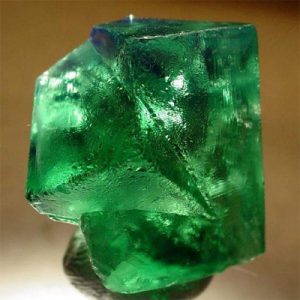Chiquitanita
Chiquitanita is a trade name (marketing term) for a rare green, a chromium-bearing variety of Chalcedony from the Chiquitania region (Chiquitos Province) of Bolivia. It’s the material that is same called “Mtorodite” or “Mtorolite” after the discovery close to the mining town of Mtoroshanga, Mashonaland West, Zimbabwe. By any of these real names, Chiquitanita, Mtorodite, Mtorolite or Chrome-Chalcedony, they all are a variety of Chalcedony coloured by small degrees of chromium. They are all comparable in features towards the better known Chrysoprase, but differ in that Chrome Chalcedony is coloured by chromium while Chrysoprase is coloured by the nickel. The two can be distinguished by a Chelsea colour filter, as Mtorodite (chrome Chalcedony) will show up red, and Chrysoprase will appear green. Chrome Chalcedony, unlike Chrysoprase, may also contain tiny black dots of chromite. Chrome Chalcedony, along with Agate, Carnelian, Chrysoprase, Heliotrope (Bloodstone), Onyx yet others, are all varieties of Chalcedony which is really a cryptocrystalline type of Quartz.
Chrome Chalcedony was trusted in jewellery and seals throughout the Roman Empire. Its usage that is earliest appears to have occurred around the first century AD and then disappeared from use sometime in the second century. The foundation of this material is unclear. Pliny it had been described by the Elder as coming from Asia, but no deposits have been found there. It may come from Anatolia (in modern Turkey) where deposits are known to exist time. Chrome Chalcedony had been not “discovered” again until 1955 near the mining town of Otorohanga in Zimbabwe. A number that is tiny of sources of chromium-bearing Chalcedony have been reported because of the mid-1980’s. It has also been discovered in Western Australia; Saricakaya, Eskisehir, Central Anatolia, Turkey; Ural mountains, Russia and from Rincón del Tigre, Chiquitos Province, Santa Cruz Department, Bolivia.
| Chemical Formula: | SiO2 + Cr |
| Silicon Dioxide (Quartz) + Chromium |


